
Western Washington www.sheetmetaljournal.com Volume 6, Number 3 Also in this issue: Heavy Metal Summer Employee Loyalty Official Journal of Record for SMACNA-WW Publications Mail / Agreement # 40719512 SHOP & SITE TOUR A SUCCESS
WHO WE ARE
SMACNA-Western Washington is a local chapter of the Sheet Metal and Air Conditioning Contractors’ National Association (SMACNA).
SMACNA Contractors are heating, ventilating, air conditioning (HVAC) and sheet metal experts. They are your assurance of quality in the fabrication and installation of ductwork and air handling systems.

SMACNA contractors are also skilled professionals in:
• Architectural sheet metal
• Industrial sheet metal
• Kitchen equipment • Specialty stainless steel
• Manufacturing and custom fabrication
• Repair services • Siding and decking • Flow testing & balancing • Energy management & maintenance
Well known and respected within the construction industry, SMACNA contractors provide the highest quality workmanship, professionalism, and service to their customers. They care about the life cycle of the project, not just the winning bid.
You’ll find SMACNA contractors working in all construction sectors whether industrial, commercial, institutional, or residential.
SMACNA contractors developed the technical manuals and standards that today are accepted worldwide in the construction community. As leaders in their industry, they continue to adopt and apply the latest technologies to HVAC and sheet metal work. Everything from duct construction and installation to air pollution control, from energy recovery to roofing, from seismic restraint to welding… they do it all!
STATEMENT OF PURPOSE

The ultimate goal of SMACNA-Western Washington, Inc. is to achieve and maintain the following principles and programs for the sheet metal industry:
1. To establish advertising, publicity, and promotional activities that advise the public of the nature, extent, and availability of services performed by the industry.
2. To promote educational programs to formulate high quality standards of sheet metal construction.

3. To aid in the formulation of uniform sheet metal specifications and improvement of state and municipal codes.
4. To expose fraudulent or misleading advertising or representations intended to deceive the public.
5. To encourage and promote trade practices that will eliminate unfair competition or exploitation of the sheet metal industry.
6. To encourage and promote the establishment of a uniform pattern of payments by customers during the progress of jobs to avoid inequitable payment delays and economic penalties.
7. To provide a forum for the discussion of the common interests and problems of labor and industry, and to encourage and promote harmonious relations between labor and industry.
8. To encourage any proper activity that will increase the efficiency of the industry and its ability to serve the public.
OUR CONTRACTORS SET THE STANDARDS
THE INDUSTRY SMACNA Contractors: Quality work and professional services
Metal and
Conditioning Contractors’
Association - Western Washington Chapter
Esq.
SE Eastgate Way, Ste
•
•
FOR
Sheet
Air
National
Executive Vice President: Julie Muller,
13810
445 Bellevue, WA 98005
Tel: 425-289-5010
Fax: 425-289-5011 www.smacnaww.org
© Can Stock Photo / Nostal6ie
PUBLISHER / EDITOR
Jessica Kirby
Direct: 250.816.3671 jessica.kirby@pointonemedia.com
SALES / CREATIVES
Lara Perraton 877.755.2762 lperraton@pointonemedia.com
CONTRIBUTORS
Eric Anderton
Peter Boileau
Kathleen Collins
Karen Forner
John Millen
Paul Vaillancourt COVER
PHOTO
PUBLISHED QUARTERLY BY
Point One Media Inc.
Sheet Metal Journal - Western Washington
P.O. Box 11, Station A Nanaimo, BC V9R 5K4
Toll-free: 877.755.2762 www.sheetmetaljournal.com
While information contained in this publication has been compiled from sources deemed to be reliable, the publisher may not be held liable for omissions or errors.
Contents ©2022 by Point One Media Inc. All rights reserved. No part of this publication may be reproduced or duplicated without prior written permission from the publisher.
Printed in Canada.
Postage paid at Coquitlam, BC.
Return postage guaranteed. Canada Post Canadian Publications Mail Sales Product Agreement #40719512.
To update or cancel subscriptions please call 1.877.755.2762, email circulations@pointonemedia.com, or visit www.sheetmetaljournal.com Official Journal of
Justin Gallimore attended a Shop & Site Tour hosted by SMACNA-WW’s SMAC-YA group that set him on the path to a rewarding career with MacDonald-Miller.
www.sheetmetaljournal.com

3
• Volume 6, Number 3
Record for SMACNA-WW
4 Editorial 5 Guest Editorial 7 SMACNA-WW Events 18 Legislative Update Find Sheet Metal Journal on Twitter and Facebook 19 It's the Law 21 Engineer’s Desk 22 Code Corner 23 Advertiser Index 10 SHOP & SITE
Photo courtesy of Justin Gallimore
TOUR SUCCESS
14 HEAVY METAL SUMMER WITH HERMANSON COMPANY After six weeks of hands-on experience in piping, plumbing, and sheet metal, nine Auburn School District students in the #HeavyMetalSummerExperience program celebrated graduation. 16 IS EMPLOYEE LOYALTY A THING OF THE PAST? Generate loyalty from your employees with three easy steps: work hard on initial fit, give your employees opportunities to develop, and recognize and reward high-performance. DEPARTMENTS FEATURES Western Washington www.sheetmetaljournal.com Volume 6, Number 3 14 Photo
of xxxxx
courtesy
THE LANGUAGE OF LEADERSHIP IN 2022
As the first year of the new normal draws to a close, leaders can look back on the skills and strategies that defined success in 2022 and begin to think about what comes next.
Crisis. Upheaval. Uncertainty.
These words defined 2020 and 2021 in ways no one could have predicted. Just about every organization on earth felt the jolts of change as, day by day, the way people work, live, communicate, and think changed. When a severe storm hits and many hit the deck and wait for it to pass, leaders are tasked with staying steadfast at the helm, eye on the horizon for solutions. This is not easy work, but it is the work that defines us as leaders.
Pivot. Shift. Disruption. New Normal. The next round of words—action words—gave us direction into new territory. Rather than charge forth with guns blazing, we had to tread lightly, but confidently, and leap to new ground, taking the whole team with us. These assured us that the flexible and adept would survive and everyone else would go the way of the Blackberry. Some at first scoffed at words like “pivot” calling it the mumblings of Millennials, but that is exactly what the most effective and resilient organizations have done. Product redesigns, strategic redirection, and flexible retraining sent organizations into the unknown because it was better than staying stagnant—or worse—in the present. And for the brave, it worked out.
Diversity. Inclusion. Work-life balance. Wellness. The words defined by the new normal feel softer but it actually requires great strength to use them. If we are going to draw these concepts into the contemporary workplace and prop them up as pillars of the way forward—often under the watchful eye of a multi-generational workforce—success will require resolve and pateince.
Because 2022 demanded a more human approach—to everything. The upside of a global crisis is that it eases the effort required to understand another person’s perspective.
By / Jessica Kirby Editor, Sheet Metal Journal-Western Washington

Among outbursts and conspiracy theorists, there were a great many sentiments about how we need to be kind because you just never know what another person is feeling. Leaders unearthed compassion they didn’t know existed and started to make time and space for every person, often getting to know them on a brand new level. Eye level.
Most importantly, leaders who stayed optimistic, built strong and agile teams, delivered smart, efficient strategies, and prepared to switch gears as needed flourished.
In 2023, we are going to need these words, plus a few others. Here they are:
1. Self-reflection
Leaders who look honestly at their own skills and abilities and immerse themselves in unfamiliar territory to stretch the limits of their comfort zones will grow in important ways, and their teams will notice. Try new training, group activities, or personal reflection exercises to start discovering the power of vulnerability.
2. Emotional intelligence
Empathy leads to trust, and trust creates transparency. Together, these build integrity and the ability to inspire others. Leaders who make decisions while considering the impact on others will help develop a more productive and invested workforce. That doesn’t mean we ask for permission or wait for consensus. It means we make decisions we can stand behind because we’ve done the work to understand their true reach.
SMACNA WESTERN WASHINGTON EVENTS & OBSERVED HOLIDAYS
Membership Meeting
November 15 | SeaTac Marriott
Annual Holiday Gala
December 2 | W Bellevue Hotel *New Location Watch your email for event invitations, details, and reminders.
Thanksgiving Holiday | Office closed November 24 & 25
Christmas Holiday | Office closed December 23–24
4
Sheet Metal Journal - Western Washington
EDITORIAL COMMENT
continued
on page 23
Have you ever made an impulsive decision, then said or done something you later deeply regretted?
We all have, but not as publicly as Will Smith.
When he slapped Chris Rock at the Academy Awards, it was literally the slap heard around the world––with billions of people watching.
From his recent apology video, it’s clear he didn’t think about the far-reaching consequences at the time of his impulsive, emotional reaction.
Will Smith could have benefited from learning the 90-second rule.
Controlling emotions
Today, I’m breaking down this powerful brain rule. I’ll give you the three steps you can take to help you control your emotions next time you’re feeling angry, fearful, insulted, jealous, or any other strong emotion.
When you were upset as a child you probably heard the advice to count to ten before you act––one thousand one, one thousand two, one thousand three…
And that was close to the 90-second rule but not quite.
The 90-second rule says that when an event happens and you feel that surge of adrenaline it only takes 90 seconds for your body to process and release those hormones.
This rule comes from Dr. Jill Taylor, a neurologist who studies brain and body function.
At 37 years old she had a massive stroke. She lost language, movement, and her relationship with reality. She eventually healed herself and used her observations to inform her work as a brain scientist. She gave an awesome TED Talk about it in 2008 called “My stroke of insight”.
Rushing stress hormones
Dr. Taylor explains that when a stressful event occurs and we have an emotional reaction, a rush of hormones goes through our brains and bodies.

They’re designed to give us the ability to escape danger. In modern life, there may not be a real danger, but we still get stressed and those hormones race through our bodies.
Road rage is an incredibly powerful example of people allowing their emotions to get the best of them. They let themselves go crazy, and they do crazy things, including shooting other people.
This is sad because Dr. Taylor says it only takes 90 seconds for your body to process and release these stress hormones.
By / John Millen, Communications Coach
What happens after that, she says, is that we get our brains caught in a loop, locked into a cycle. And that’s all caused by our thoughts. By controlling your thoughts, you can break the cycle.
So given that, the next time you have a major event or even a smaller event, like frustration with traffic, that triggers you, use the 90-second rule.
I discovered this rule during the start of covid in early 2020. It’s been extremely helpful.
Here are three steps I follow that will help you control your emotional response to events. These are my words, based on Dr. Taylor’s research.
1. Feel the rush
When something happens that provokes you, I recommend you just stop and feel the chemical reaction in your body. Unless you’re facing a real threat, don’t instantly react or take any physical action.
Instead of focusing on the emotions you feel, just sit and feel the sensations in your body. The adrenaline running through you.
2. Wait for the release
After 90 seconds, you’ll feel the hormones subside. If you stay focused, you can actually feel them releasing in your body. Just sit and wait for the tide to turn.
Then I recommend you focus your breath. Your heart rate will be racing and your breathing will be shallow. Take a few slow, deep breaths.
Try it now. Take a deep breath.
Do you feel how that calms you? This is the best way to calm your body, your brain, and your nervous system.
3. Break the cycle
When you’ve settled your body and brain, you can patiently decide what comes next. At this point, with your mind starting to calm, you can make a more rational choice.
Then think about it: Here’s how I’m feeling right now, here’s the emotional response I wanted to give.
5 www.sheetmetaljournal.com • Volume 6, Number 3
THE 90-SECOND RULE
GUEST EDITORIAL
Is this response necessary? Will it achieve the best outcome?
It may feel good to yell at someone or say something nasty or sarcastic but will it help or hurt your relationship in the long term?
This is how you break the cycle.
This means that for 90 seconds you can watch the process happening, you can feel it happening, and then you can watch it go away.
Trapped in an emotional loop
After that, if you continue to feel fear, anger, and so on, you need to look at your thoughts. They are re-stimulating your brain’s circuitry. Dr. Taylor says that results in you having this physiological response over and over again. Being trapped in an emotional loop.
This is a valuable insight. If our bodies are capable of processing the emotional reaction in 90 seconds, we are the ones who continue to ruminate on the event, instead of processing it to resolution or letting it go.
This is the key: none of us has control over the events we face. The only thing we can control is our response to those events.
The person who said this best is Viktor Frankl. He survived the horrors of Nazi concentration camps and learned the power of controlling one’s response. He said:
Between stimulus and response there is a space. In that space is our power to choose our response. In our response lies our growth and our freedom.
When you face a stressful event this week, instead of reacting emotionally try to be an observer of your body for 90 seconds––feel the emotions, the hormonal rush. Then experience your body processing these chemicals to relief.
At that point, your body has done its job. The next move is up to you. How you respond to emotional situations can make or break your relationships.
Don’t have regrets like Will Smith. In contrast, I commend Chris Rock. I suspect he knows the 90-second rule because he implemented it in three seconds, when he decided not to retaliate but to be a consummate professional and move on.
By using the 90-second rule you give yourself power over your emotions. This rule can change your life and the lives of people all around you. ▪
Reprinted with permission from the author. Read more from John Millen at johnmillen.com/blog or check out his videos on communication techniques at youtube.com/channel/UCg8DnSvJQfQ5xI3sx3IvBTg
The Sheet Metal and Air Conditioning Contractors’ National Association (SMACNA) is an international trade association representing contracting firms throughout the United States, Canada, Australia, and Brazil. The mission of SMACNA is to create a competitive advantage for SMACNA members through industry education, labor relations, standards development, industry representation, and business studies. SMACNA members are innovative and forward-thinking sheet metal contractors who specialize in Heating, Ventilation, and Air Conditioning, Architectural & Industrial sheet metal, Manufacturing, Testing & Balancing, and Energy management.
Sheet Metal and Air Conditioning
Contractors’ National AssociationWestern Washington Chapter Executive Vice President: Julie Muller, Esq. 13810 SE Eastgate Way, Ste 445 Bellevue, WA 98005

Tel: 425-289-5010 • Fax: 425-289-5011 www.smacnaww.org
CONTRACTOR MEMBERS
ACCO Engineered Systems
AccuDuct Manufacturing, Inc.
Air Handlers, Inc.
AIRTEST Co., Inc.
Apollo Mechanical Contractors
Argo Blower & Mfg. Co., Inc.
Auburn Mechanical, Inc.
Ballard Sheet Metal Works, Inc.
Capital Heating and Cooling, Inc.
D/B Solutions, LLC
Delta Technology Corporation
Distribution International
Eckstrom Industries, Inc.
Emerald Aire, Inc.
ENVIROMECH
Evergreen State Heat & AC
GB Systems, Inc.
Gensco, Inc.
H & R Mechanical Systems, Inc.
Hermanson Company, LLP
Holaday-Parks, Inc.
Holmberg Mechanical
Johansen Mechanical, Inc.
L & M Sheet Metal Fabricators, Inc.
MacDonald-Miller Facility Solutions, Inc.
McKinstry Co., LLC
Miller Sheet Metal, Inc.
Miller’s Smith & Losli Sheet Metal, Inc.
Neudorfer Engineers, Inc.
NW Mountain Air, Inc.
Olympia Sheet Metal, Inc.
Pacific BIM Services
Penn Air Control, Inc.
Phoenix Mechanical, Inc.
Pinchiff Mechanical LLC
PSF Mechanical, Inc.
PSR Mechanical
Schmitt’s Sheet Metal & Roofing
Scott & From Co., Inc.
Shinn Mechanical, Inc.
Sunset Air, Inc.
Trotter & Morton Facility Services
TRS Mechanical, Inc.
UMC, Inc.
AFFILIATE MEMBERS
ACI Mechanical & HVAC Sales
Ahlers Cressman & Sleight
Air Reps, LLC
AIREFCO, Inc.
Armacell, LLC
ATS Automation
Automated Controls DBA Albireo Energy, LLC
Barnhart Crane and Rigging (DBA Magnum)
CL Ward, Inc.
C.M. Hoskins Company
CliftonLarsonAllen, LLP
Cole Industrial, Inc.
Consolidated Supply Co. DFG Advisors
Dorse & Company, Inc.

Ductmate Industries
ECCO Manufacturing, Inc.
Edge Construction Supply
Employer Solutions Law
First Metal & Supply
General Insulation Company, Inc.
Gripple, Inc.
Hudson Bay Insulation
ISAT Total Support
Industrial Air Systems, Inc.
Johns Manville
Johnson-Barrow, Inc.
MacArthur Co.
Mestek Machinery
Milwaukee Tool
Pacific Product Sales, Inc.
Parker, Smith & Feek
Performance Contracting, Inc.
PlanGrid/AutoDesk
Star Rentals Inc.
SPI, LLC
Sunbelt Controls
Sunbelt Rentals
Trane Valley Mechanical Insulation York NW Factory Direct
6 Sheet Metal Journal
Washington GUEST EDITORIAL
- Western
SMACNA-WESTERN WASHINGTON MEMBERS
DIVERSITY, EQUITY & INCLUSION SUMMIT 2022
SMACNA-WW held its first DE&I Summit this summer with 51 participants coming out to learn more about cultural change in the workplace when it comes to creating a seat at the table for every person. The summit is the latest in a series of efforts the association is making to promote DEI and the benefits of a diverse and welcoming workplace culture and industry.
“In 2021, SMACNA-WW held its first DE&I Panel via Zoom during Women in Construction week,” says Patricia Bovie, marketing and design manager for SMACNA-Western Washington. “This year, SMACNA-WW continued to address DE&I by holding in an in-person event. Additionally, a new DE&I committee has been formed to serve the association beginning in 2023.”
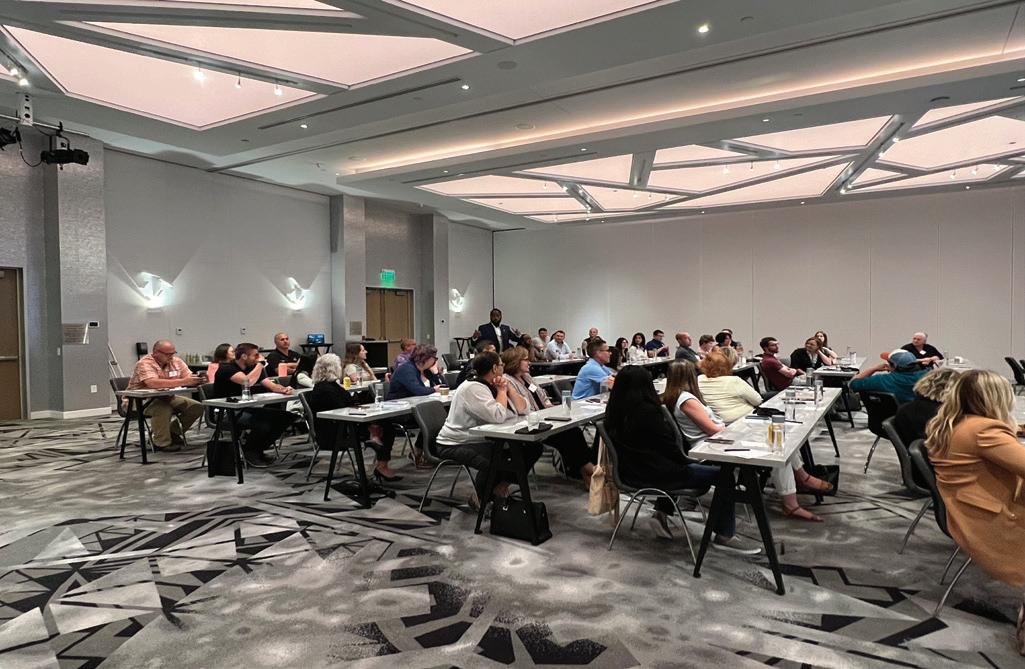
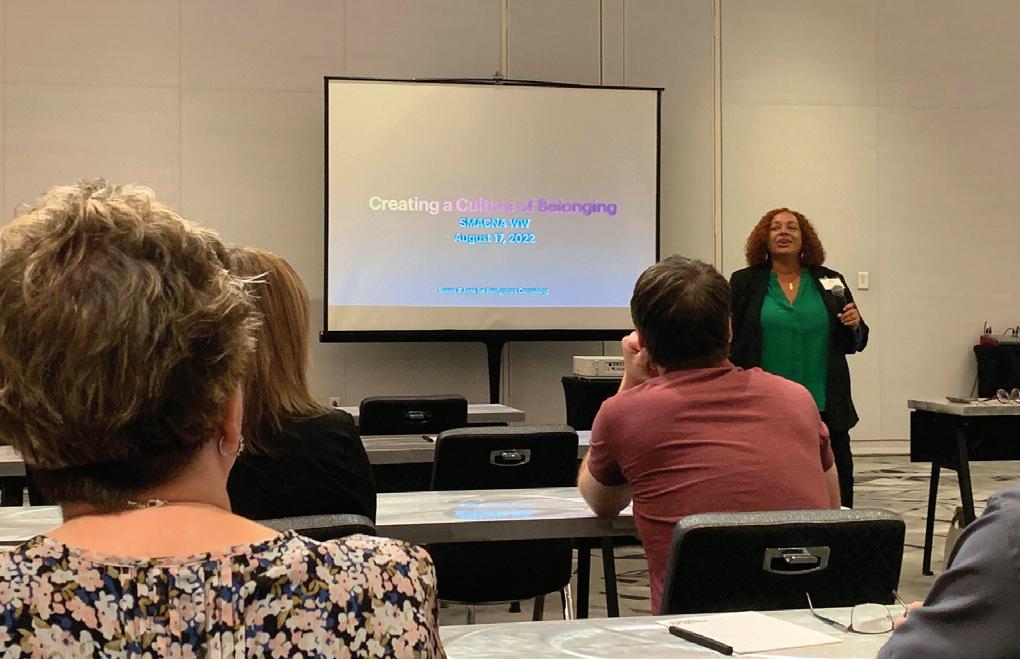
Boosting Inclusion in the New Normal
The last few years have brought lots of cultural change into the workplace. What does this mean for teams and leaders looking to avoid the pitfalls—and maybe even tap into the promise—of our diverse world? In this session, Susan X Jane, Principal of Navigators Consulting, explored current language, thinking, and practice around diversity, equity, inclusion, and belonging.
is to expand our awareness around how bias and prejudice informs our thoughts, feelings, and behaviors. The lack of awareness around our bias can be damaging to the meaningful relationships that we would like to cultivate. Thus, it is important to address the more hidden ways our prejudice manifests through our implicit biases and microaggressions. In this interactive session, participants Dr. Nevin J. Heard, DEI consultant, facilitator, and co-founder of XNY Genes, LLC, a social equity consultant company, gave participants the opportunity to engage in experiential activities to increase their awareness surrounding implicit bias and microaggressions. Following this session, attendees were able describe implicit bias and discuss tools they can use to deconstruct it.
About the Speakers
“Our speaker referrals came through Executive Vice President Julie Muller’s Yale MBA networking group,” Bovie says. “Both did an excellent job at engaging the audience members and posing thoughtworthy group discussions on DE&I.”
Working with the group, Jane introduced basic concepts of identity, culture, and bias, and spoke about the shifts in culture showing up in the work and the workplace. Participants learned basic tools for building belonging on teams, creating an inclusive environment ready to bring cultural fluency into the work with clients and collaborators, and how to connect with more diverse workers, clients, and communities.
Making the Implicit Explicit: Expanding Our Awareness Around Bias
As the United States becomes increasingly diverse amid socially tense times, an increased cultural humility becomes more important for day-to-day interactions in the workplace and beyond. One important way to increase cultural humility
Susan X Jane has more than 25 years of experience exploring race and representation in both the public and private sectors. Susan is a transracial adoptee, a Black woman raised in a white family and community, an experience that created an early focus on the way race and gender shape our concept of ourselves and each other.
Susan has worked to address race and culture as a community organizer, program developer, professor of communications, and consultant to corporations and impact focused institutions. As principal of Navigators Consulting, Jane draws on decades of experience to work with organizations in both the public and private sector to support learning growth and inclusion.

7 www.sheetmetaljournal.com • Volume 6, Number 3
SMACNA-WW EVENTS
To any who seek to build a better world, she offers her skills as teacher, coach, and strategic partner to help businesses, social impact organizations and communities create diverse and inclusive environments where the humanity of all is respected and protected.
Dr. Nevin J. Heard works as DEI consultant and facilitator at XNY Genes, LLC, a social equity consultant company with the single mission: to bring about greater social equity through partnerships with forwardthinking organizations who have the same mission in mind. Additionally, Dr. Heard serves as an Assistant Professor of Clinical Counseling focusing on multicultural and social justice issues and centering the intersectional realities of racial minorities, LGBTQ+ populations, people of low socioeconomic status, and those affected by HIV/AIDS. Dr. Heard’s scholarship around multiculturalism has resulted in over 30 international, national, and regional conference presentations and invited lectures, speeches, workshops, and publications. Dr. Heard has spent over a decade in diversity, equity, and inclusion work focused on transformation at intrapsychic, interpersonal, community, and organizational levels.
“In the industry, there is a lot of discussion about labor shortages and recruitment,” Bovie says. “I think addressing DE&I efforts is crucial to attracting the next generation of workers and retaining the best talent.”

Attendees had the chance to win the grand raffle prize at this event: A Women’s Louis Vuitton Handbag.
Congratulations to our winner, Liz Kelley-Fong with MacDonald-Miller Facility Solutions, Inc.

Members interested in requesting the presentation slide deck provided by the guest speakers, can email pbovie@ smacnaww.org to receive a copy. ▪
OKTOBERFEST SPOOKTACULAR

On October 27, SMACNA-WW held its Oktoberfest Spooktacular event at the Lounge by Topgolf in Kirkland, WA. Over 60 members gathered in the lounge to celebrate spooky festivities, play virtual games, and dance to a live band!
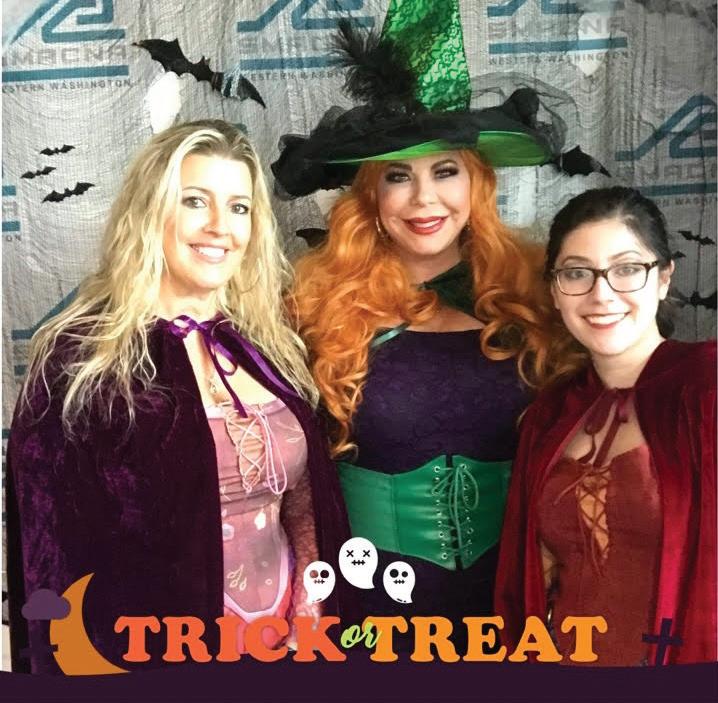
Lounge by Topgolf
Lounge by Topgolf is located on the second level of Kirkland Urban off Central Way in downtown Kirkland, just five miles north of downtown Bellevue. SMACNA-WW reserved the entire space along with the outdoor patio for this private event.
Virtual Games
TopGolf features variety of exciting virtual games, including classic Topgolf challenges, baseball pitching, a quarterback challenge, hockey shots, even Zombie Dodgeball.
Attendees could also tee it up on more than 80 virtual courses, including iconic locations like Pebble Beach, Oakmont Country Club, Pinehurst #2, and Royal Melbourne.
Congratulations to Olympia Sheet Metal for winning the costume contest for their creative Rock, Paper & Scissors group costume! ▪
8 Sheet Metal Journal - Western Washington
SMACNA-WW EVENTS
SMACNA-WESTERN WASHINGTON
HOLIDAY GALA
SMACNA-Western Washington is excited for this year’s Holiday Gala on the evening of Friday, December 2 at the W Hotel in Bellevue, WA. Everyone on the SMACNA-WW team is ready to welcome you back to enjoy festivities inperson again. This is one holiday event you won’t want to miss!









Your holiday gala reservation includes a holiday reception, dinner, program, door prizes, professional photos, and special live entertainment and music.
Holiday greetings will be presented by Outgoing President Tom Montgomery, President Elect BJ Giri, and Executive Vice President Julie Muller. The program will also include member service and lifetime achievement awards and will conclude with the installation of the 2023-2024 Executive Committee and Board of Directors.
Giving Tree (NEW)
This year, SMACNA-Western Washington would like to collect donations at our holiday gala for those less fortunate this holiday season. If you would like to participate, please bring a gift card with you to the gala. We will be hanging the gift cards as ornaments on a holiday Giving Tree that will be displayed at the gala. Afterwards, SMACNA-WW will be distributing the gift cards to local charities around the Puget Sound region. Thank you in advanced for any donations.
For more information, please contact the SMACNA-Western Washington office at pbovie@smacnaww-org ▪
9
SMACNA-WW EVENTS
Shop & Site Tour Success
By / Jessica Kirby
Back in 2019, SMACNA-Western Washington’s SMAC-YA group, comprised of people looking to draw youth together and into the sheet metal industry, arranged a Shop & Site Tour for students attending community colleges and universities in the Seattle area. Networking, education, and recruitment activities geared to young people are the business of SMACYA, SMACNA-WW’s Young Leaders Association, which focuses on attracting young members to the association and industry.
“The event was open to college students interested in a fastpaced, innovative, and challenging career in commercial construction,” says Patricia Bovie, administrative services co-ordinator for SMACNA-Western Washington. “We asked several community colleges to invite their students to join us for a site tour of the new Rainier Tower building in downtown Seattle by MacDonald-Miller Facility Solutions and a McKinstry Co. shop tour. Afterwards, we provided a chance for members to network with young professionals at a Happy Hour hosted at Bowlero South Seattle in Tukwila, Wa.”
Fifteen students from Edmonds Community College, Renton Technical College, Seattle University, and University of Washington participated in the event, designed to demonstrate what a career in sheet metal looks like on the site and in the shop.
One of those students was Justin Gallimore, then a construction management student at Renton Technical College. At the time, he was fascinated by the tour and experiencing parts of the construction industry he’d never seen before, but he wasn’t quite ready to jump into a career in sheet metal. He had school to complete and other opportunities to explore. Today, he is enjoying a fulfilling, dynamic career as a project engineer with MacDonald-Miller and loving every minute of it.
Getting started
At the time of the Shop & Site Tour, Gallimore was working full-time waiting tables while attending Renton Technical College full-time. Even with a flexible restaurant schedule, he still found it difficult to go to school full-time.

Justin Gallimore always knew construction was in his future, but it was a Shop & Site Tour hosted by SMACNA-WW’s SMAC-YA group that set him on the path to a rewarding career with MacDonald-Miller.
10 © Can Stock Photo / Emevil
“Renton Technical College’s Construction Management program was amazing, though, and professors always found a way to work with my schedule and made sure that I was doing well,” he says.
He’d always loved the construction trades. Growing up, he was surrounded by people working in the trades, including both his parents, both his grandparents, and both his brothers.
“I knew the Shop & Site Tour would expose me to a side of construction that I hadn’t seen before,” he says. “Most importantly, I’d hoped it would help expand my network in the industry.”
The tour
SMACNA-Western Washington’s Site & Shop Tour was designed to give students a first-hand look at a day in the life of a sheet metal worker. The first stop on the tour was Rainier Square Tower, an active jobsite provided by MacDonald Miller in downtown Seattle. Students arrived by shuttle bus and met tour guides, who took the participants in the lift up to the 40th floor of the tower. The lift scaled the outside of the building, providing stunning views of downtown Seattle during the ascent.
“I was thoroughly impressed,” Gallimore says. “Sending us right into the project, up the lift to the 40th floor was amazing, almost overwhelming… in a good way,” he says. “There was so much to soak in and lay eyes on.”
After touring the top levels, students took the lift back down to the ground level where guides explained more of the mixeduse retail space on the bottom floor.
“During the tour, guides explained how the revolutionary core is constructed using steel frame around a concrete core,” says Bovie. “This was especially useful to students interested in the modern engineering of the tower.”
The second stop on the tour was McKinstry’s office and sheet metal shop. During lunch they received an educational presentation about McKinstry’s fabrication shop and the tools and technologies that generate 3D models of fabrication pieces before production.
After lunch, the group toured the shop and learned about all the work that occurs off of the jobsite, and how pre-fab saves a massive amount of time and project costs. “That alone was quite intriguing,” Gallimore says. “A task that could take two weeks in the field can now be completed in just four days in the field due to prefab. This was such an amazing process to see unfold right before my eyes.”
The tour’s final stop was the office, which demonstrated the significant amount of pre-construction work that takes place prior to when any of the fabrication or installation even begins. Tasks included using 3D modeling to verify equipment, systems, and parts compatibility.

“This is another great example of the cost/time efficiency we saw out in the field,” Gallimore says. “Overall, this tour was eye opening and inspired my interest in the construction industry, but most importantly, where the industry is going.”
The day concluded at Bowlero South Seattle where a bowling Happy Hour was held with SMACNA members for networking. Students were able to capitalize on the networking opportunities with different companies that attended the bowling happy hour and exchange contact info.
Decisions, decisions
Though thoroughly impressed and inspired by the tour, Gallimore didn’t jump into he construction career immediately. “I didn’t want to jump the gun, as in pursuing a career without reviewing other opportunities, as well,” he says. “Especially since I was still attending Renton Technical College as a fulltime student and living in Lake Stevens, Wa, so the driving was a lot, in the first place.”
Shortly after this tour, Gallimore was offered an opportunity as an Assistant Superintendent with Exterior Finishes LLC. The company’s office was based out of Lake Stevens, which drastically influenced his decision to accept the position. Just shy of a year with that company he was promoted to Superintendent and spent just over a year running his own multi-family and commercial construction projects.
“This was a great opportunity for me to get hands-on experience in the construction management field while I was attending RTC and after I graduated the program,” Gallimore
11
“What I enjoy the most is the hands-on experience with multiple tasks on two different projects in two entirely different phases. I have access to all our foreman on site and in office, and they are always willing to answer my questions... everyday a learning opportunity.”
—Justin Gallimore, project engineer, MacDonald-Miller
says. “My key goal was to get as much experience in the construction industry as possible before graduating.”
Coming full circle
Eventually, he came back to MacDonald-Miller, enticed by the prospect of growth and room to move within the company.
“Everything I had toured years ago was still the same—a healthy/efficient environment and, especially, the drive to reduce our carbon footprint,” he says. “That alone was inspiring for me to see—a company still pushing and standing behind their very own word and exceeding those expectations.”
Today, Gallimore works as a Project Engineer for the newly constructed Washington State Convention Center and the Washington 1000 17-storey office building across the street from the convention center. At the time of writing, he was wrapping up the last of material submittals for Washington 1000 and reviewing daily requests for information on this project.
As for the Convention Center, he does quality control, install checks, radiant manifold pressure checks, assists with equipment startups/tests, and is putting together the equipment training for when the building is 100% ready for owner turnover.

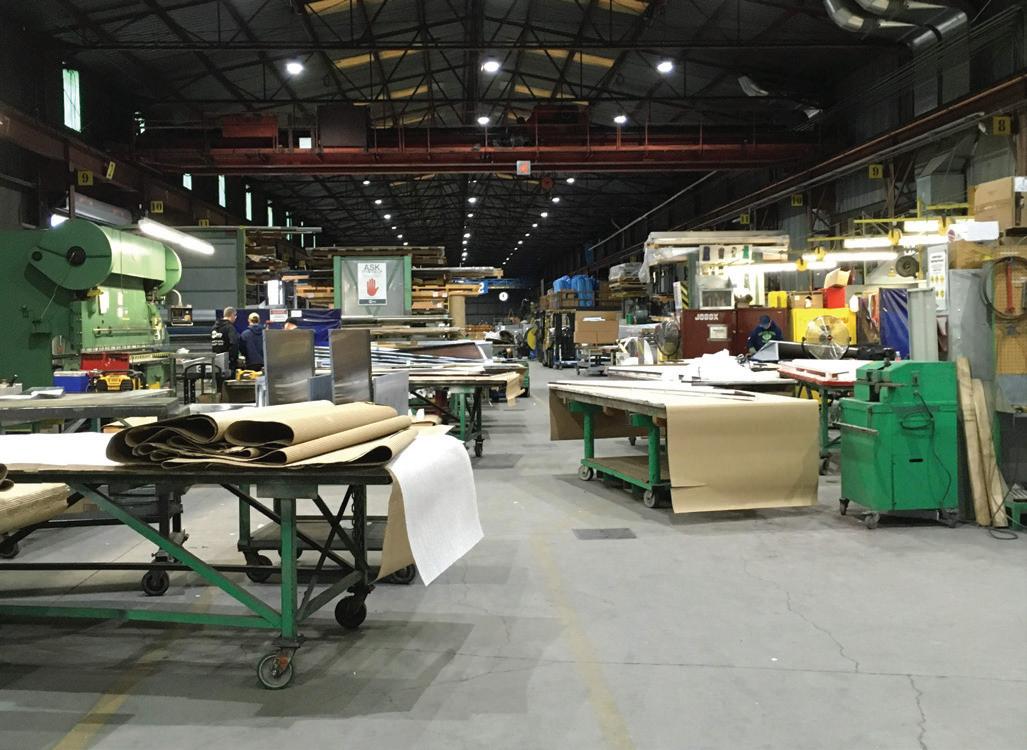



“What I enjoy the most is the hands-on experience with multiple tasks on two different projects in two entirely different phases,” he says. “I have access to all our foreman on site and in office, and they are always willing to answer my questions. This makes everyday a learning opportunity.”
Advice for up-and-comers
Gallimore has some advice for people who are still in school and perhaps reserved about getting into the construction/sheet metal/mechanical industry.
“I highly recommend you just jump right in,” he says. “There is so much room for growth and an extensive amount of opportunity if you have the drive to want it. Also, stay eager to learn more and always ask questions. You’d be surprised what information you can acquire from co-workers and your uppers.”
▪
12 Sheet Metal Journal - Western Washington


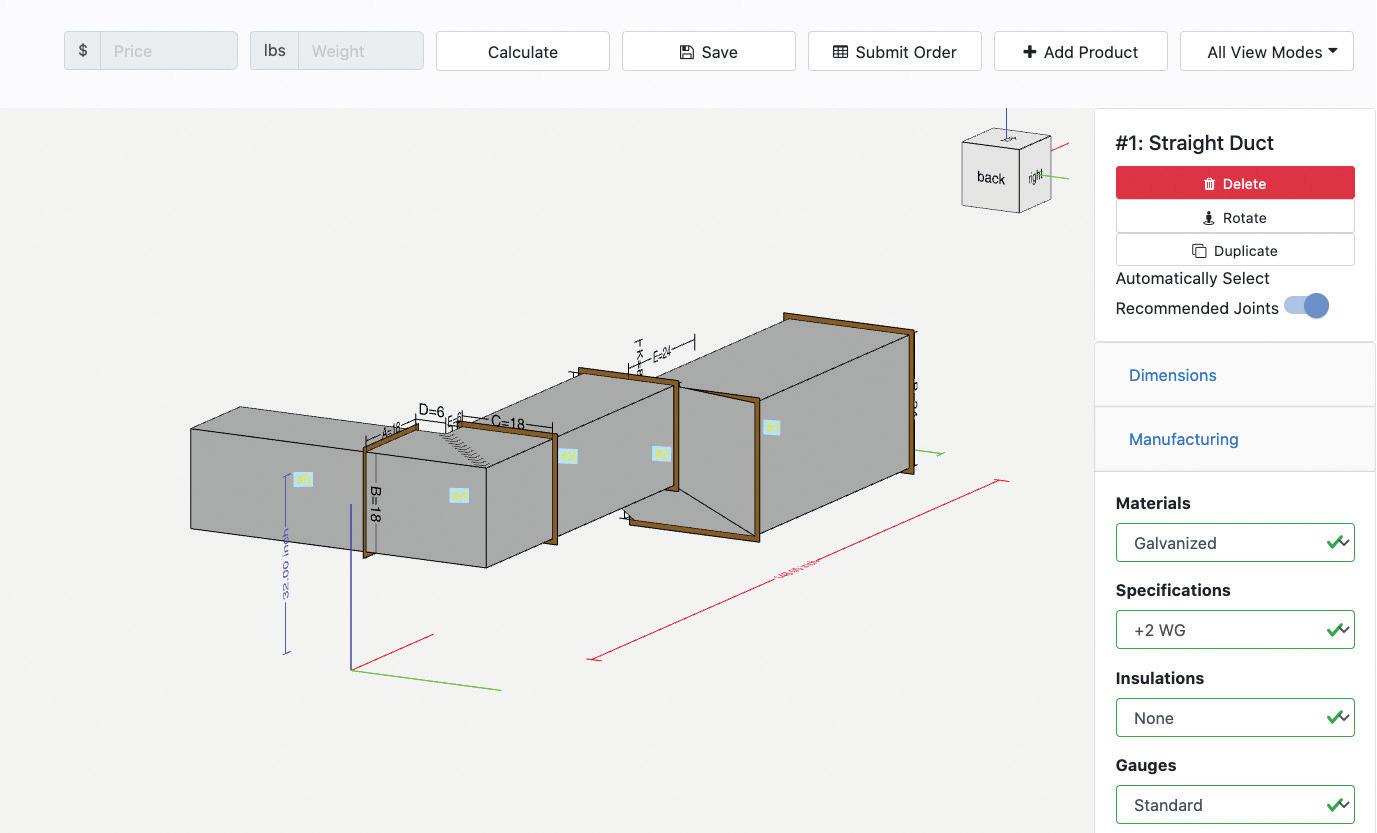





























































































































































































































































































































































































































































































































































































































































































































www.sheetmetaljournal.com • Volume 6, Number 3 Allows site foremen to create mechanical systems in 3D • Empowers foremen to use as-built content Generates a cost and price for material and labor, plus Provides foremen working on major and special projects to send fabrication-ready models to the shop for fabrication and Configurable fabrication standards and recommendations are • Easy to implement being cloud native INTRODUCING THE BUILDCENTRIX ASSEMBLY BUILDER NEW Taking Fabrication and Estimation to a Whole New Level See it for yourself. For a free trial, call us toll-free at 1-855-932-3828 or email support@buildcentrix.com. Visit www.buildcentrix.com to schedule an online demo today.
© Can Stock Photo / 3DMAVR
Heavy Metal Summer with Hermanson
Mechanical Contractor Hermanson Company Offers Trade Experience to Underserved Teens
After six weeks of hands-on experience in piping, plumbing, and sheet metal, nine Auburn School District students in the #HeavyMetalSummerExperience program celebrated their graduation at Hermanson Company in Kent, WA, on Thursday, August 4, 2022.



Co-founded by Hermanson Company and Western Allied Mechanical(Menlo Park, CA), the Heavy Metal Summer Experience (HMSE) is a free program for underserved high school students to gain exposure to all aspects of mechanical construction. Hermanson is committed to promoting awareness of career options for students and creating more diversity within the building trades workforce.
“Our job is to give the students experiences to explore and let them find what they’re great at and where their natural genius is,” said Rick Hermanson, CEO of Hermanson Company. “This allows kids to find what success looks like for them and learn that the building trades offer great careers and pay well. It also creates the awareness that there are alternatives to college.”
With shortages of skilled tradespeople entering the industry, programs like HMSE are part of a national movement to help young people discover rewarding careers that shape the skylines of their communities. In its inaugural year in 2021, HMSE was launched at Hermanson in Washington State and Western Allied Mechanical in California. This year, the program has grown to 11 hosting companies in five states across the United States.
Author, TV Host, and Hermanson’s Director of Oregon Operations Nick Kasik joined the graduation celebration as a guest speaker. He shared his personal experience as someone who has built his career working in the trade industry and now promotes the trades and vocational career options.
“These trades careers can take you places you can’t imagine if you just let it,” he said. “My life has truly been an adventure, and no other career could have taken me where it’s taken me or allowed me to see what I’ve seen. It can be the same for you. Be different, go into the trades, and allow them to take you somewhere different.”
Over the course of the free program, these hard-working students attended training sessions hosted by Hermanson
Sheet Metal Journal - Western Washington 14
Words & Photos courtesy of Hermanson Company
craftspeople, toured local apprenticeship centers, and learned about what a career in the trades can offer. Students showed off their skills and pride in craftmanship by creating various projects, including sheet metal lanterns, welding belt buckles, toolboxes, and more. They also toured Local 66 and Local 32 Plumbers and Pipefitters, where they met instructors and learned more about joining the trades.
“This opens the doors and shows kids who may not be able to afford college that they don’t have to work minimum wage jobs,” said Cindy Wright, whose daughter Alex graduated from the program. “You can survive and thrive. We went from ‘I have no idea what I’m going to do after high school’ to ‘I’m going to join this union.’ It’s been huge.”
Thanks to generous donations from partners and sponsors, like Milwaukee Tool and Northwest Sheet Metal Workers Organizational Trust, HMSE provided each student with work boots, standard construction industry personal protection equipment (hard hat, vest, safety glasses, and gloves), and a complete toolkit. The tools and boots were theirs to take home at graduation. SMACNA-Western Washington also supports the program through funding and administrative support.
The six-week Heavy Metal Summer Experience career camp will return to Hermanson in 2023 when a new class of high school students is introduced to what careers in the trades can offer. Parents and students interested in attending or learning more can contact Jana Burbank at jburbank@hermanson.com

For companies interested in hosting a HMSE camp at their facilities, please visit the Heavy Metal Summer Experience website at hmse.org.
Hermanson Company is a full-service mechanical contracting, engineering, and service company with over 700 employees in Washington and Oregon ▪
The HMSE Playbook

The HMSE Playbook is a 125-page manual developed to share with interested contractors or JATCs to aid them in hosting camps at their facilities. It provides sample applications, permission releases, and video and media releases, as well as sample schedules, projects, and lessons learned.
“We tried to think of everything they might need to run the camp,” says Angie Simon, co-founder of HMSE. “I have received feedback from numerous camps last summer that the playbook was very valuable to help them plan their camp—it is designed to be a ‘Easy Button’ for the camp hosts.”
The Playbook details the curriculum and sample itineraries based on Western Allied Mechanical’s and Hermanson Company’s inaugural camps, and includes several photos of classroom and shop activities, projects, and exceptionally happy-looking students.
HMSE in the Summer of 2022

This past summer, the following local areas hosted HMSE camps:
• Greater Los Angeles area – 2 camps (Superior Duct Fabrication and LA JATC)
• Greater Bay area – 4 camps (Western Allied Mechanical, Silicon Valley Mechanical, ACCO, and Peterson Mechanical)
• Greater Seattle area – 2 camps (Hermanson and Johansen Mechanical)
• St. Louis, Missouri – 1 camp (SMACNA St. Louis, held mostly at the JATC with tours of contractors’ shops)
• Boston, Massachusetts – 1 camp (JC Cannistraro)
• Birmingham, Alabama – 1 camp (Hardy Inc.)
“We anticipate about 30 locations around the nation next summer—the above 11 plus the following locations: Buffalo, Atlanta, New Mexico, Nebraska, two in Iowa, Chicago, one just outside of DC, another Boston, another Seattle, Michigan, maybe Texas, San Diego, Wisconsin, and hopefully New York area,” Simon says. “Last summer we had about 170 students, and next summer I anticipate 425!”
Learn more at hmse.org
15 www.sheetmetaljournal.com • Volume 6, Number 3
Is Employee Loyalty a Thing of the Past?
By / Eric Anderton Photo by Hyppolyte de Saint-Rambert
Have you ever heard of Hachiko, the golden-brown Akita dog? Hachiko was a familiar sight at the Shibuya train station in Tokyo, Japan. Each evening he would go down to the station to greet his owner Mr. Ueno on his return from work at the local university. One day Mr. Ueno did not appear. He had suffered a cerebral hemorrhage at work and died.
Nearly a decade of commitment
For the next nine years, nine months and fifteen days, Hachiko went down to the train station, at precisely the time the Mr. Ueno’s train was supposed to arrive and waited for his master. As the years passed, the dog became famous throughout Japan for his remarkable loyalty.

Here’s what you need to do to generate loyalty from your employees:
1. Work hard on initial fit
2. Give your employees opportunities to develop
3. Recognize and reward high-performance
Step 1: Work hard on initial fit
The reason some companies struggle to generate loyalty from employees is found in the initial hiring process. Desperate
to fill open positions, organizations recruit people who are technically qualified, but are a poor fit with the culture of the company.
One of my construction clients has a very competitive culture. The purpose of their business is to “Crush the Competition”. That competitive spirit permeates how they run their business, and they work hard to make sure that they hire people who share that drive to succeed.
They’ve taken time to define their culture. This guides them in the interview process to structure questions that dig into job candidate’s experiences with, and attitudes towards, a competitive environment. The responses to those questions help them to filter through potential employees and identify people who are more likely to fit in with the vibe of the company prior to bringing them on board.
The hiring decision is just the beginning. Immediately following that you have to turn your attention to the second step of building loyalty.
Step 2: Give your employees opportunities to develop Once you’ve got a cultural fit, you have to make sure you
16 Sheet Metal Journal - Western Washington
provide opportunity for employees to develop and grow. Talented people don’t like to stagnate, and if they don’t feel challenged, they’ll soon be looking for openings with more dynamic organizations.
Provide “tours of duty” for ambitious people. For example, a construction company might hire someone as a project manager, and after a year or two move them into estimating to give them a taste of what it takes to win projects. They could even go into the field for a few months as a superintendent to gain a deeper understanding of how to build a profitable project.
Opportunities increase as people’s horizons expand. They not only gain technical knowledge, but they also build relationships inside and outside the company. You may also find that as they make progress they emerge as potential leadership candidates.

If you nail initial fit and work on developing your people, they’ll produce great results, which will lead to the final step of locking in loyalty…
Step 3: Recognize and reward high-performance Employee loyalty sky-rockets when people feel appreciated.
Savvy leaders not only recognize people for outcomes such as achieving a sales quota or completing a project; they also reward behaviors that exemplify the values that drive the organization.
When did you last “catch” your employees excelling? If your company is uniquely devoted to customer service, make sure you “catch” your people when they go above and beyond to take care of your client’s needs. It’s easy to get used to high-performers doing well, and you can slip into neglecting to give them the recognition they deserve. Don’t make this mistake. Genuine, specific, consistent recognition plays a huge part in locking in the loyalty of talented people.
But where can I find the time to do all this work? Some business owners complain that they are too busy running their business to take the time to go through the loyalty building steps described in this article. This is a very narrow
perspective, and it misses one of the most important jobs of a leader: attracting, developing, and retaining talented people.
Focus on the up and comers
One of my clients has been in business for over 25 years, and they intend to continue for at least another 25. That’s why they’ve committed to leadership development classes for up and comers in their company. They’ve also paired them up with a mentor to help them continue their growth in the business.
The battle for talent is not ending anytime soon. Savvy companies understand their future depends on getting, growing, and keeping good people, and they are dedicated to locking in the loyalty of their best employees.
Hachiko stuck around for years waiting for his master, and his loyalty was commemorated with a statue. Dogs and humans are different, and you need to work harder to generate deep commitment from your employees then you will from a friendly mutt.
Make sure new hires fit your culture, get challenged to grow in their careers, and receive the recognition they deserve.
A simple next step
I provide my clients with a tool called the Leadership Dashboard. They use it to help high-potential employees clarify eight key areas that every top performer needs to consider. The dashboard helps them stay focused on important priorities, key business relationships, and ongoing professional growth.
High performers are much more likely to stick with your company if they are clear about how they can continue to grow and contribute to your organization.
If you’d like a copy of the Leadership Dashboard, you can access it at constructiongenius.com/leadersdashboard.
Reprinted with permission from the author.
17 www.sheetmetaljournal.com • Volume 6, Number 3
“Talented people don’t like to stagnate, and if they don’t feel challenged, they’ll soon be looking for openings with more dynamic organizations.”
LEGISLATIVE UPDATES
2023 LEGISLATURE – REVISITING PAST
ISSUES WITH NEW FACES
The 2023 session starts in January, just a few months from now. The November election is not likely to change Democrat control of the House and Senate, but with a long list of retirements, there will be plenty of new members who will deal with issues both new and old. Overall, the 2023 session looks to be one with lots of discussion on current issues, many of them controversial. Before the 105 days concludes in April, the Legislature must also pass its two-year budgets.
New Faces
There will be a lot of new faces. Six of the 49 senators are retiring. Seventeen out of 98 House members are not returning, nearly all due to retirements. Four House members are trying to fill vacated Senate seats and are likely to win. Many of the retirees are long-time Democrat committee chairs, which means we will see new faces in key committees and House leadership, too. Overall, seven House committee chairs and two Senate committee chairs won’t be returning.
One of the retirees is Representative Pat Sullivan from Covington who has held the influential second in command Majority Leader spot in the House for several years. The odds are that the current House Environment and Energy Chair, Representative Joe Fitzgibbon from West Seattle, will move into the Majority Leader spot, opening the chairmanship in that committee. This committee deals with a lot of issues of interest to SMACNA—Clean Buildings, natural gas use in buildings, hydrofluorocarbons, and all manner of climate related legislation. The long-time House Labor Committee Chair, Representative Mike Sells from Everett, is retiring. Other House committee chair spots that will be open include health care, insurance, and finance. In the Senate, the Environment and Energy Committee will have new leadership with the departure of Senator Reuven Carlyle from Seattle. There will be at least two other new committee chairs in the Senate. And of course, the membership of many of the committees in both Houses will change with the influx of new members and shuffling around of the current ones.
Issues – New and Old
Just watch the news and you can predict the hot topics for the 2023 session. The economy and price of gas and necessities are likely to spur a lot of conversation, but probably not a lot of relief. The major environmental laws passed in recent years will go into effect in 2023 and may start to increase the price of gas, but decreases in the state gas tax are unlikely. The weaker economy will mean less growth in the budget and hopefully avoidance of new taxes and fees. The controversial capital gains tax passed in 2021 is still working its way through the court system and thus far has been declared unconstitutional. Efforts to repeal it will be introduced but almost certainly will be rebuffed by the majority party.
By / Kathleen Collins, Government Relations Consultant

Modifications to the 2021 police reform laws will be a theme in the 2023 session. The Governor’s state of emergency on the pandemic will officially end October 31 after 975 days. There will be renewed efforts in the 2023 session to set limits on the length and scope of Governor declared emergencies and require greater involvement from the Legislature. The Long-Term Care insurance law that was to go into effect in January 2022 was suspended until the end of the 2023 session to give legislators time to assess the financial viability of the program. We expect this insurance will continue in some form. It is not clear if the efforts to remove the requirement for employees to participate will be successful. The paid family leave program will undergo similar financial scrutiny after the Legislature had to provide an infusion of general fund money last session because program usage is exceeding the revenue from employees and employers contributions.
Climate Issues
The Inflation Reduction Act will provide an infusion of federal money into the state for environmental purposes, including rebates for alternative fuel cars and tax credits for new renewable projects and generation. Despite the changes the Building Code Counsel is expected to adopt limiting the use of natural gas in residential and commercial construction, we expect there will be bills introduced that go even further to limit fossil fuel use with the goal of phasing it out over time.
In August, Governor Inslee announced that Washington will follow California with a ban on the sale of gas-powered vehicles by 2035. In 2020, the legislature adopted a goal to this effect, but it is not a legal requirement in state statute. Governor Inslee is relying on the federally delegated Clean Air law provision that allows other states to adopt California’s stricter vehicle emission standards by rule. Some other states are following suit. The ban would apply to passenger cars, light-duty trucks, and medium-duty passenger vehicles, such as SUVs and vans. There will be efforts to stop or modify this mandate in the 2023 session.
All in all, it looks like the 2023 session will be interesting with lots of new members and plenty of controversial issues.
18 Sheet Metal Journal - Western Washington
▪
EQUAL PAY AND OPPORTUNITY ACT
The Washington Department of Labor and Industries enforces the Washington Equal Pay and Opportunities Act. The Department’s website outlines key provisions of the Act that are provided below:
The Equal Pay and Opportunities Act prohibits gender pay discrimination and promotes fairness among workers by addressing business practices that contribute to income disparities between genders. Both employees and applicants have rights under this law.
Employee Rights
• Equal pay, not based on gender
• Equal career advancement opportunities, not based on gender
• Ability to discuss wages with others
• Access to wage or salary information of a new position or promotion, upon request by the employee
• Protection from retaliation
Job Applicant Rights
• Privacy of wage or salary history when applying for a job
• No requirement for wage or salary history to meet certain criteria
• Access to minimum wage or salary information of a new position, upon request
Employee Protections
It is unlawful to base an employee’s pay or career advancement opportunities on their gender. Employees also have the protected right to discuss their wages and have the right to access certain wage and salary information.
Equal Pay
Gender cannot be a reason for pay differences between employees with similar jobs. Determining if employees have similar jobs is based on skill, effort, and responsibility, not based on job titles. Differences in pay for similar jobs may be acceptable only in certain circumstances.
Acceptable Reasons for a Difference in Pay
Unequal compensation between employees of different genders may be acceptable if the difference is not based on gender. Acceptable factors for differences in pay may include:
• Differences in education, training, or experience
• Seniority
• Merit/work performance
• Measuring earnings by quantity or quality of production
• Regional differences in compensation
• Differences in local minimum wages
• Job related factors consistent with business need
Employers bear the burden of proof to justify why pay differences
By / Karen Forner Attorney, Marketing Director, Founder, Employer Solutions Law

exist. An employee’s previous wage or salary history cannot be used to justify gender pay differences.
Equal Career Advancement Opportunities
Employers cannot limit or deprive an employee of career advancement opportunities on the basis of gender.
Acceptable Reasons for Differences in Career Advancement Opportunities
Differences in career advancement opportunities between genders may be acceptable if the difference is based on:
• Differences in education, training, or experience
• Seniority
• Merit/work performance
• Measuring earnings by quantity or quality of production
Open Wage Discussions
Employers cannot prohibit employees from disclosing, comparing, or discussing their wages or the wages of other employees. Wage non-disclosure agreements for employees are prohibited.
There's more to SMJ than just our magazine and website. Do you use Facebook? Great! LIKE us at facebook.com/ sheetmetaljournal.
19 www.sheetmetaljournal.com • Volume 6, Number 3
IT'S THE LAW
Employers can require employees who have access to other employees’ wage information as part of their job duties, to keep that information confidential.
Access to Wage or Salary Information
Employers must provide an employee who is offered an internal transfer or promotion with the wage scale or salary range of their new position, upon request by the employee. If a wage scale or salary range does not exist, the employer must provide the minimum wage or salary expectation set by the employer prior to posting the position, making a position transfer, or offering the promotion. Employers with fewer than 15 employees do not have to meet this requirement.
Protection from Discrimination, Retaliation, and Firing
Employers cannot take any adverse action against an employee for discussing wages, filing a complaint, testifying in a proceeding related to the law, or exercising other protected rights granted under the Equal Pay and Opportunities Act. Additionally, employers cannot retaliate against employees who ask about their wages or lack of opportunity for advancement.
Applicant Protections
Hiring practices such as asking an applicant for their salary history or requiring a minimum previous salary to be considered for a new position can contribute to ongoing earning inequalities and are prohibited by law.
Wage and Salary History Privacy
Employers cannot seek the wage or salary history of an applicant. An employer may confirm an applicant’s salary after the employer negotiates and makes an offer of employment, including pay, to the applicant.
Employees can voluntarily disclose their wage or salary history to prospective employers.
Protection from Wage and Salary History Requirements for Applicants
Employers cannot require that an applicant’s prior wage or salary history meet certain criteria.
Access to Minimum Wage or Salary Information for Applicants
Employers must provide an applicant who is offered a position with the minimum wage or salary of the position they are applying for, if requested by the applicant. Employers with fewer than 15 employees do not have to meet this requirement.
Beginning Jan. 1, 2023, employers will have to include some required information in their job postings. That includes a wage/ salary range and a general description of all benefits and other compensation. These requirements apply only to employers with 15 or more employees. L&I’s Employment Standards Program anticipates developing an administrative policy to help employers better understand the requirements of this legislation.
More information on the Act can be found at lni.wa.gov/workersrights/wages/equal-pay-opportunities-act ■
Since 1993, Karen Forner has been working on Labor and Industries issues and employment law matters. Her background includes working at the Attorney General’s Office in the Labor and Industries Division for 14 years. After working as a Senior Attorney at a private law firm, in 2009 Karen founded K-Solutions Law—now Employer Solutions Law—in Bellevue, Washington. Karen and the firm advise employers statewide on matters of workers’ compensation, workplace safety (WISHA/DOSH/OSHA), wage and hour, prevailing wage, and employment law All the while, Karen has also become an industry-wide speaker and is often called upon to do training presentations across the state and nation.
Submit your news, story, or photo idea
CONTRACTORS AND SUPPLIERS
SMJ-WW is on the lookout for interesting HVAC, architectural sheet metal, testing & balancing, and industrial/specialty news and feature topics. If you have a great idea, notice an industry issue that needs addressing, or want to weigh in on a technical subject, we would love to hear from you.
We also need great pictures—current and historical—of people working in all aspects of the sheet metal industry. If you have something to share, please email it to our editor, Jessica Kirby, with a caption about what is going on in the photo.
Questions about how else to get involved in a future issue of Sheet Metal Journal? Reach out to jessica.kirby@pointonemedia.com or 250.816.3671 to get the scoop.
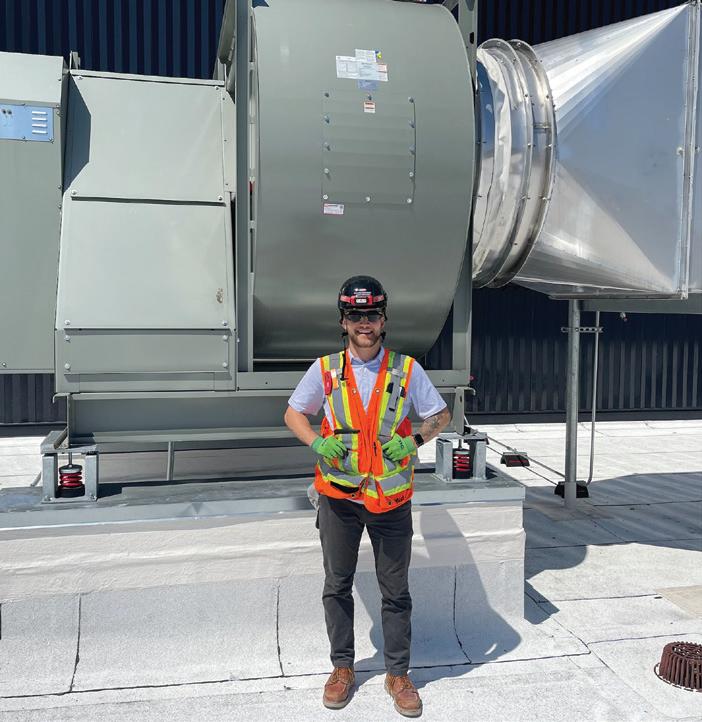
20 Sheet Metal Journal - Western Washington
IT'S THE LAW
Western Washington www.sheetmetaljournal.com Volume 6, Number 3 Also in this issue: Heavy Metal Summer Employee Loyalty Official Journal of Record for SMACNA-WW SHOP & SITE TOUR A SUCCESS
INTRODUCTION ON AIR TO WATER HEAT PUMPS
It’s no secret that heat pumps are making a come back in a big way and they are here to stay.
Driven by environmental concerns, policy, and government rebates—not to mention the ability to provide cooling—this fast-growing market trend is making a big impact in the HVAC industry and is now expanding to include hydronic heating systems.
Heat pump technology has advanced tremendously in the past decade, allowing the units to offer much higher performance at lower outdoor temperatures, even as low as -30 degrees C for some models. This was unheard of just a decade ago.
When it comes to hydronic systems, there are several options available to take the place of fossil fuel boilers. They can be classified in three distinct categories: monobloc, split system, and heat pump boiler. The heat pumps can be further classified as conventional, inverter, or cold climate heat pumps (CCHP). The selection for the type of heat pump that will be used can be dependent on a mechanical contractor’s ability to support the product they install, their level of comfort with the system, and the application.
Let’s talk about the advantages and disadvantages for each type of system.
Monobloc Heat Pump Advantages:

These air-to-water heat pumps are totally self-contained and only require water lines to be connected from the outdoor unit to the indoor buffer tank. They are typically equipped with inverter driven compressors that make them quiet and efficient. Some models include the circulator built into the appliance, and they usually include a small electric heater (usually 3Kw or less) to help supplement the unit’s capacity during colder weather. These units are installer friendly since there are no refrigeration field connections to make.
Disadvantages:
Monobloc systems require freeze protection throughout the entire hydronic system unless a heat exchanger is installed downstream of the buffer tank. The cost for a heat exchanger, circulator, and other components may often exceed the cost of anti-freeze for the entire system. Propylene glycol should be the anti-freeze of choice.
Technical expertise is required to service or repair the units. The skills required include refrigeration, controls, and hydronics. A secondary source of energy should be included in the system design in the event of a unit failure.
 By Paul Vaillancourt North American HVAC Products Ltd.
By Paul Vaillancourt North American HVAC Products Ltd.
Split System Air-To-Water Heat Pumps

Advantages:
This type of system uses an indoor module where a refrigerant-towater heat exchanger is installed. Like a monobloc but separated into two components (indoor and outdoor), the split system does not require anti-freeze in the system since there are only refrigerant lines between the indoor and outdoor units.
Disadvantages:

Like monobloc units, the split system indoor units may include a small electric heater and a circulator. The system design should include a back-up system in the event of a unit failure. Split system units require the same skill level as monobloc systems with the addition of the skills and tools required to install a line set, charge a system, and proper commissioning.
Heat Pump Boiler Systems
The heat pump boiler system has many advantages since it offers great technology in its simplest form. It is an electric boiler equipped with a refrigerant-to-water heat exchanger. The electric boiler can be operated independently from the heat pump, in combination with the heat pump, or as a heat pump only system. This type of system allows the designer to use the heat pump for radiant floor systems and use the boiler for high temperature loads, such as domestic hot water through
21 www.sheetmetaljournal.com • Volume 6, Number 3
ENGINEER’S DESK
CIRCU LATOR PUMP AIR BLEED WATER FROM FLOOR LIQUID REFRIGERANT LINE AFTER HEAT IS REMOVED PRESSURE RELIEF INDOOR UNIT HYDRONIC SUPPLY MANIFOLDS ELECTRIC BOILER INFLOOR PEX REFRIDGERANT TO WATER COAXIAL HEAT EXCHANGER (WATER PRE-HEAT) continued on page 23
SMACNA GETS BUSY: UPDATES COMING OUR WAY!
Our SMACNA technical committee partners at the national level have been busy this year developing updates to a number of different tools, manuals, and guidelines, both previously published and in one case a new manual that addresses a new industry needing our expertise and guidance. Below is a summary of what’s “coming down the duct” to assist and change your business in the near future.
SMACNA will be releasing its completed Ductulator tool for use on both IOS and Android operating systems. This powerful application can be downloaded from the SMACNA national website later this year onto your mobile device to develop quicker and more accurate designs. The tool can store multiple projects as well as design alternates within projects for comparison purposes. It has the ability to design based on friction loss, velocity, or both together based on your parameters, to assist in selecting the most efficient size and configuration of ductwork for your customers. It includes a user selected air compression percentage (10% compression recommended) to accurately account for real world compression that occurs in our duct systems. It also includes a user selection menu for a wide variety of duct materials/roughness factors to assist in selecting the right combination of materials and associated pressure loss/fan horsepower required in any system you design.
During our last Western Washington ICC Code/Technical Advisory meeting we reviewed a number of new SMACNA Technical Resource Bulletins, including rooftop ductwork applications and installation recommendations, recommendations for using tie-rods for duct reinforcement, and grease duct reinforcement standards. These technical bulletins are primarily tools to guide designers in the above subjects, although the tierod recommendations are meant to provide additional guidance for proper duct fabrication. As the committee reviewed these tie-rod recommendations, we were at times uncertain about how tie rod sizes and placement are calculated from this guide. It appears that we were not alone, as SMACNA national has just released an additional tie-rod clarification guide. This new guide is meant to eliminate confusion on how to size and place internal tie-rods, specifically to clarify how to size and place rods in positive pressure ductwork versus negative pressure duct. It includes a new worksheet to assist us in calculating duct loads in negative pressure duct systems, which have much larger loads than positive pressure systems. This clarifications bulletin indicates that negative pressure systems 2” water gauge and higher need to use ¾” diameter conduit instead of ½” and limit mid-panel tie rods to ductwork widths 96 inches and less (larger than this width require external reinforcement). In addition, they limit the use of internal tie-rods to ducts with velocities of 2,500 feet per minute and more.
By / Peter Boileau, Chairperson SMACNA-Western Washington Code & Technical Committee

The long-anticipated release of the SMACNA Seismic Restraint Manual: Guidelines for Mechanical Systems 4th edition will be available in early 2023. This update to the 3rd edition published in 2008 includes significant changes to the way we currently brace our mechanical systems. The 4th edition will require bracing systems to align with the State of California’s Office of Statewide Health Planning and Development (OSHPD) requirements. This will change the way we currently calculate anchorage requirements and potentially how we size and select anchors. The new edition will limit the use of cable systems and increases the allowable type and size of steel angles if used to brace our work. The new manual will also include new bracing schedules, examples, and details to assist us in understanding how these new bracing requirements will apply. For the first time many of the details in the manual will be available in Revit format. Although the changes are significant, the authors of the 4th edition of this manual have stated that the approach used is more simplified and intuitive than in previous editions, and I think we all would welcome a more straightforward process to select, fabricate or purchase, and install our seismic bracing systems.
A new, 6th edition of the Fire, Smoke and Radiation Damper Installation Guide for HVAC is coming our way in 2023. It will include a very useful code comparison matrix to match types of fire separation walls, ceilings, and shafts (as defined in the International Building Code) to duct and damper requirements. This will greatly simplify both plan review and field inspection interpretations of these conditions. The new edition also has expanded guidelines for testing of smoke/fire dampers and has updates on breakaway duct connections and fire/smoke dampers.
For those of us who fabricate and install large rectangular duct systems (widths exceeding 10 feet) a new, 3rd edition of the SMACNA Rectangular Industrial Duct Construction Standards will be available next year. This new edition includes construction standards for fabricating rectangular duct with panel widths from 12 to 16 feet wide. It also has new tables for 2.5-foot external stiffener spacing for various pressure classifications, and revised duct loading tables for exterior ductwork subject to snow, ice, and wind loads. It includes
22 Sheet Metal Journal - Western Washington
CODE CORNER
continued on page 23
continued from page 4
3. Feedback This is a more fluid, holistic type of communication than yearly reviews, micromanaging, or only communicating with the workforce for disciplinary reasons. Leadership objectives like enhancing behavior and shifting performance are far more accessible if feedback is balanced, frequent, and brief. Consider check-ins, text messages, or weekly acknowledgements to support others. When delivering corrective feedback, be curious (rather than angry), and engage the other person in the solution. Top-down is so three years ago.
4. Growth Mindset A fixed mindset says, “This is the way we’ve always done it,” “If it’s not broken, don’t fix it, “That person is smart, strong, good at his/her job.” A person with a growth mindset says, “Let’s try something different,” “How can we improve this,” “That person works hard/is creative/ has so much potential.” Leaders with a growth mindset are more likely to lead teams to victory because the people in those teams are free to think, try new things, make mistakes, be accountable, and persevere. Not everything in a storm ends up broken. Some things bend, sway, and ultimately survive. Be one of them. ■
ENGINEER’S DESK
continued from page 21
an indirect water heater. The boiler can produce 180 degrees F water for this application. Heat pump boilers are typically available with up to 20Kw of electric heat.
Advantages:
• Quick and simple installation
• 100% back-up built in
• Boiler can be operated stand-alone with heat pump installed at a later date
• No anti-freeze required
• Quiet and efficient
• Extremely reliable due to simplicity in design
• Can be used with indirect tank for 100% domestic hot water
• Designed to connect with inverter heat pumps for maximum efficiency
Disadvantages:
• Requires a refrigeration technician for line set, charging, and commissioning of the heat pump system.
All Systems
While there is mention in this article about systems that may not require anti-freeze, this may not be the case where extremely cold temperatures would require that the indoor portions of a system be glycolyzed for burst protection. It is also good practice to use propylene glycol for systems producing chilled water for cooling. ■
Paul has been in the HVAC industry for over 40 years with his roots in working for the family business in the Ottawa area in the 1970s. His thirst for knowledge over the years, and always wanting to find a better way, has afforded him a high level of expertise in many areas of the HVAC industry. He is the National Sales Manager/ Technical Trainer for North American HVAC Products Ltd. and can be reached at paul.v@nahvac.com
CODE CORNER
continued from page 22
guidelines on the use of stainless-steel material to include Class 2, 3 and 4 constructions, and stainless-steel duct systems operating/carrying air and particulates at up to 500 degrees Fahrenheit.
Another pair of updated technical manuals coming our way next year is the 4th edition of the HVAC Systems Testing, Adjusting & Balancing Guide and the 5th edition of the Duct Design Manual. The new edition of the balancing guide replaces the 3rd edition published in 2002, and the new edition of the design manual replaces the 4th edition published in 2006. These two manuals have been developed simultaneously to ensure that ductwork systems are properly designed so that they properly work to eliminate problems requiring rework of installed systems discovered during testing and balancing.
And finally, SMACNA national is busy updating its Kitchen Ventilation Systems and Food Service Equipment Fabrication and Installation Guidelines, first published in 2001, and they are starting work on a new Grow House “Cannabis” Ventilation Systems technical manual, which will address multiple, unique issues involved with this new industry. Stay tuned for more information on these guidelines as we receive updates. ■
advertiser index
advertiser page phone website
BuildCentrix 13 855.932.3828 www.buildcentrix.com
SMACNA-WW IFC, 6 425.289.5010 www.smacnaww.org Star Rentals OBC 800.825.7880 www.starrentals.com
www.sheetmetaljournal.com • Volume 6, Number 3
23
ADVERTISER INDEX
EDITORIAL
STAR RENTALS
IN TODAY’S FAST-PACED ENVIRONMENT, YOU NEED A PARTNER WHO UNDERSTANDS YOUR BUSINESS AND CAN KEEP YOU MOVING… FORWARD.
PARTNER WITH STAR RENTALS.
When you work with Star Rentals, you know you are getting high-quality, modern equipment that is ready when you are. No downtime. And we offer competitive pricing and local decision-making, to keep you on budget.
As the Pacific Northwest’s largest independent construction equipment rental company, we have helped countless companies get where they need to go. Safely. Quickly. Forward

YOU FORWARD
TOLL-FREE 800-825-7880 WWW.STARRENTALS.COM
Choose
Rentals!
MOVING
Your business is on the move…
Star



























































































































































































































 By Paul Vaillancourt North American HVAC Products Ltd.
By Paul Vaillancourt North American HVAC Products Ltd.



